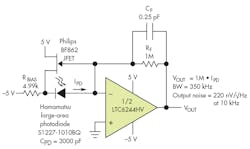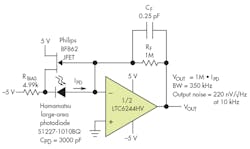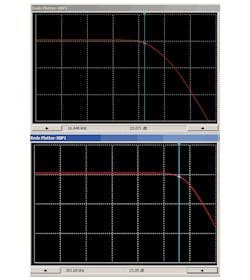Matched JFETs Improve Photodiode Amplifier (.PDF Download)
Linear Technology has a good application note about using a discrete JFET to improve the ac response of a large-area photodiode. The circuit uses the JFET as a voltage follower on the cathode side of the photodiode (Fig. 1). This nulls the effect of the diode's internal resistance and capacitance. If there’s no voltage change across the diode, the resistance and capacitance have no effect on the circuit. And the photocurrent generated by the diode is unaffected by the bootstrapping action of the JFET.
1. This circuit uses a JFET to bootstrap the cathode of the photodiode. It eliminates the effect of diode resistance and capacitance. This improves bandwidth and reduces noise, but puts a dc voltage across the diode.
The bandwidth of the JFET is greater than the amplifier, so the bootstrapping action extends to the unity-gain bandwidth of the amplifier. The bootstrapping makes the photodiode's 3000-pF internal capacitance appear to be zero at the amplifier input. Removing this capacitance will eliminate the input pole, or lag, from the circuit and allow you to use a smaller compensation capacitor. This will extend the frequency response of the circuit (Fig. 2).
2. Spice plots demonstrate the improvement in circuit bandwidth offered by JFET bootstrapping. Without the bootstrapping, the circuit bandwidth is 16.6 kHz. With the bootstrapping JFET, the bandwidth increases to 383.7 kHz.


